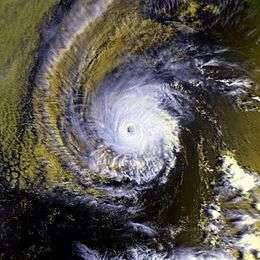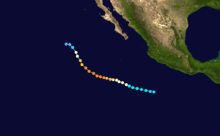Hurricane Ramon
| Category 4 major hurricane (SSHWS/NWS) | |
 Hurricane Ramon at peak intensity on October 10, 1987 | |
| Formed | October 5, 1987 |
|---|---|
| Dissipated | October 12, 1987 |
| Highest winds |
1-minute sustained: 140 mph (220 km/h) |
| Fatalities | 5 indirect |
| Damage | Minimal |
| Areas affected | Mexico (Baja California), Southwestern United States (California, Nevada, Arizona, Utah, Colorado) |
| Part of the 1987 Pacific hurricane season | |
Hurricane Ramon was a very intense Pacific hurricane that generated heavy rains in Southern California. The 19th named storm and final hurricane of the above-average 1987 Pacific hurricane season, Ramon originated from a tropical disturbance that formed in early October. On October 5, a tropical storm had developed several hundred miles southwest of Manzanillo, bypassing the tropical depression stage. Tropical Storm Ramon turned to the west-northwest after initially moving west. It intensified into a hurricane on October 7. Two days later, Hurricane Ramon peaked in intensity with winds of 140 mph (220 km/h). After peaking, Ramon turned to the northwest and rapidly weakened over cooler waters. It weakened into a tropical storm on October 11 and a depression on October 12. Ramon dissipated shortly thereafter. While at sea, Ramon brought light rainfall to the Baja California Peninsula. The remnants of Hurricane Ramon produced heavy rainfall that caused flooding in California, indirectly contributing to five traffic-related fatalities. Rainfall was reported as far inland as Utah.
Meteorological history

Hurricane Ramon originated from a tropical disturbance that was situated south of a large ridge over Central Mexico. The disturbance became better organized while traversing 84 °F (29 °C) waters and at 1800 UTC on October 5, the Eastern Pacific Hurricane Center (EPHC) upgraded the disturbance into a tropical storm while centered about 575 mi (925 km) southwest of Acapulco.[1] Initially, the storm was expected to move west and not affect land; however, this did not occur.[2] After being named, Tropical Storm Ramon held onto marginal tropical storm intensity for 24 hours. Thereafter, Tropical Storm Ramon turned west-northwestward and began to intensity. At 1200 UTC on October 7, the EPHC reported that Ramon had intensified into a hurricane. About 24 hours later, the system was upgraded into a Category 2 hurricane on the Saffir-Simpson Hurricane Wind Scale (SSHWS). Rapidly intensifying, Ramon reached major hurricane status on October 8 (Category 3 or higher on the SSHWS). At 0600 UTC on October 9, Ramon was upgraded into a Category 4 hurricane[3] while reaching its peak intensity of 140 mph (220 km/h),[1] which it maintained for 24 hours.[3]
After attaining peak intensity, Hurricane Ramon began to weaken. Late on October 10, Ramon weakened slightly while turning northwest. The following morning, the storm reportedly weakened into a Category 2.[3] Hurricane Ramon began to rapidly deteriorate due to a combination of jetstream interactions and increasingly cold sea-surface temperatures.[1] At 0600 UTC on October 11, the storm was downgraded into a Category 1 on the SSHWS after bypassing the Category 2 stage. It weakened into a tropical storm later that day and was further downgraded to a tropical depression on October 12. Tropical Depression Ramon dissipated on 0600 UTC that day.[3] The remnant moisture of this hurricane later moved into Southern California, resulting in record rains.[1]
Preparations and impact
Although Hurricane Ramon was far from the state of California at that time, a flash flood watch was issued for southern Orange, San Diego, western San Bernardino and Riverside counties, citing uncertainty in the storm's path.[4][5][6] Additionally, "alerts" were also posted over a wide area that included the Santa Ana Mountains, the Laguna Mountains, Lake Arrowhead, and Joshua Tree National Monument.[7] While still at sea, the storm produced high waves along the Pacific coast in the Baja California Peninsula; Cabo San Lucas reported waves 3 ft (0.91 m) high.[6] The outer rainband's of Hurricane Ramon brought scattered showers to the region.[8]
The remnants of this storm caused extremely heavy rains across Southern California,[1] peaking at 2.14 in (54 mm) in Camp Pendelton.[9] A total of 0.5 in (13 mm) of rain was reported in San Diego,[10] resulting in street flooding.[11] Torrential rainfall was recorded in San Diego County, where two people died in separate traffic accidents.[12] Further north, in the city of Los Angeles, three more people perished in separate traffic incidents.[7] Heavy rains extended west and was also reported in Hemet in Riverside County,[7] where three people were also injured during a car accident.[8] The rains caused a week-long forest fire 16,000 acre (65,000,000 m²) on Mt. Palomar to dissolve.[7] Several streets were closed in Orange County and San Diego County. One library's roof leeked, as such, books had to be covered for protection.[13] Furthermore, the Spring Creek River overflowed its banks.[14] Elsewhere, the moisture spread rains to Nevada, Arizona, Utah, and southwestern Colorado.[15] The tropical moisture also helped end a 37-day dry spell in Salt Lake City, marking the longest time the city went without rain since 1964. Nation-wide, Ramon killed five people, all due to road-related incidents.[16]
See also
| Wikimedia Commons has media related to Hurricane Ramon (1987). |
References
- 1 2 3 4 5 R.L. Cross (1988). "Eastern North Pacific Tropical Cyclones of 1987". Monthly Weather Review. American Meteorological Society. 116. Bibcode:1988MWRv..116.2106C. doi:10.1175/1520-0493.116.10.2106.1.
- ↑ Eastern Pacific Hurricane Center; E.B. Gunther and R.L. Cross; National Weather Service Western Region (Fall 1988). "Annual data and verification tabulation, eastern North Pacific tropical storms and hurricanes, 1987". National Weather Service.
- 1 2 3 4 National Hurricane Center; Hurricane Research Division; Central Pacific Hurricane Center. "The Northeast and North Central Pacific hurricane database 1949–2015". United States National Oceanic and Atmospheric Administration's National Weather Service. A guide on how to read the database is available here.
- ↑ "Snow, Record Cold Hit U.S.". The Gainesville Sun. October 13, 1987. p. 1. Retrieved June 16, 2013.
- ↑ McLean (October 13, 1987). "West gets much-needed rain".
- 1 2 Jack Jones (October 10, 1987). "Hurricane Could Spawn Some Raine". The Los Angeles Times.
- 1 2 3 4 "Storm Brings Record Rain". The Union Democrat. October 13, 1987. p. 5. Retrieved June 18, 2013.
- 1 2 "Cold on the Plains, Snow on Vermont". United Press International. October 13, 1987.
- ↑ A History of Significant Weather Events (PDF). National Oceanic and Atmospheric Administration (Report). National Weather Service Forecast Office San Diego, California. 2005. p. 37. Retrieved June 18, 2013.
- ↑ "The Weather Today". The Union Democrat. October 12, 1987. p. 6. Retrieved June 18, 2013.
- ↑ "5 dead in S. California is Storm's last Punch". San Jose Mercury News. October 13, 1987.
- ↑ "Dying Hurricane Sprinkles Rains to Southland". Daily News of Los Angeles. October 13, 1987.
- ↑ Storm Data and Unusual Weather Phenomena (PDF) (Report). National Climatic Data Center. 1988. p. 15. Retrieved June 28, 2013.
- ↑ "San Jose Mercury News (CA) – October 13, 1987 – 8B California News Record San Diego Area Rains Help Control Big Brush Fire". San Jose Mercury News. October 13, 1987.
- ↑ "Floyd Loses Its Punch". The Dispatch. October 13, 1987. p. 6. Retrieved June 18, 2013.
- ↑ "Domestic News". Associated Press. October 13, 1987.
